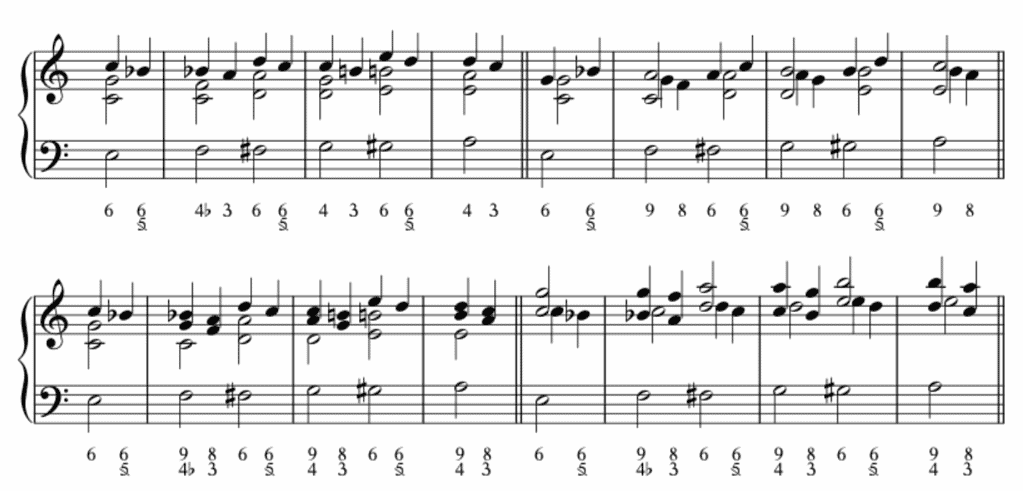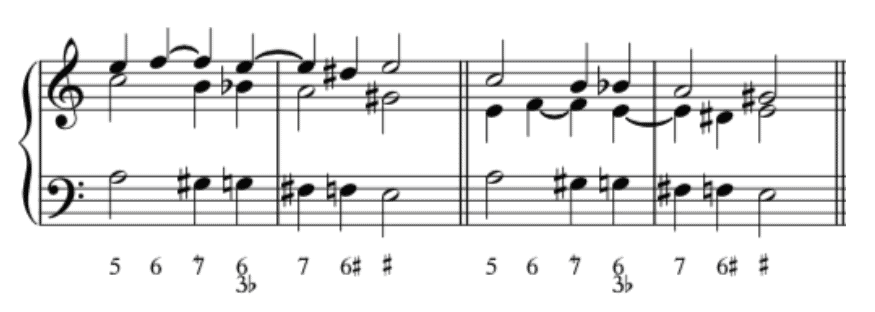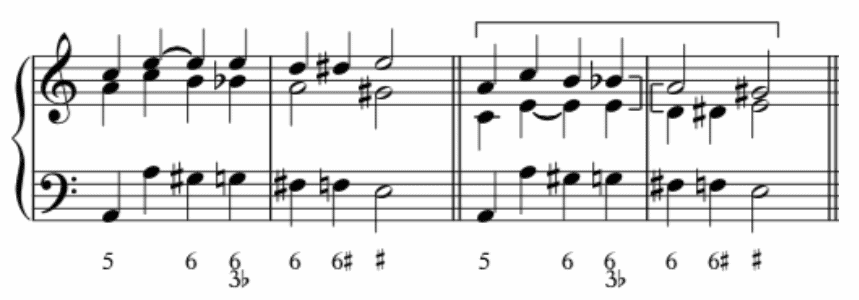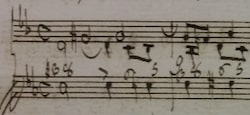In my previous two essays (Diatonic Moti del Basso that Rise Stepwise and Diatonic Moti del basso that Descend Stepwise), I dealt with the moti del basso that rise and descend stepwise.
The topic of this essay is chromatic moti del basso, both rising and descending. There are 3 such basic bass progressions. Two of them are rising (from ③ to ⑥ (aka Monte) and from ⑤ to ①), one is descending (from ① from ⑤ (in one setting aka Morte)).
To facilitate the reading of this essay, I use Robert Gjerdingen’s black-circled figures to indicate scale steps in all the parts except those in the bass, which I denote with white-circled figures. And I add an accidental to a figure when the specific designation of a diatonic or a chromatically altered scale step is required, although this symbolized notation can differ from the actual one. The list below should suffice to make the system of indications clear. Regardless of the mode,
♭③ always refers to the scale step a minor third above ①
③ always refers to the scale step a major third above ①
♭⑥ always refers to the scale step a minor second above ⑤
⑥ always refers to the scale step a major second above ⑤
♭⑦ always refers to the scale step a major second below ①
⑦ always refers to the scale step a minor second below ①
Moti del Basso That Rise Chromatically
③=>⑥ (aka Monte)
In this moto, the bass rises chromatically from ③ to ⑥ in major, with ③, ♯④ and ♯⑤ acting as local leading notes, and ④, ⑤ and ⑥ as local tonics. Joseph Riepel called this pattern a Monte (Italian for mountain). Since each segment consists of a local ⑦–① bass line, each segment acts a ⑦–① cadence (or a clausula cantizans or what Gjerdingen calls a Comma). ⑦ can be set as a sixth chord or as 6/♭5 chord, ① as a triad.

The triads can also be enriched by one or two suspensions:

Note how the 6/♭5 chords are horizontalized.
Although Fenaroli specifically links this moto to the major mode and has it end on ⑥ (i.e. consisting of three segments), it also occurs with only two segments, ending on ⑤, a variant that also occurs in the minor mode. In the latter case, the third scale step in the bass is chromatically raised.
(More variants of this moto can be found in eighteenth-century compositions and will be dealt with in a series of essays on the Monte.)
⑤=>① in Minor
The bass of this moto rises chromatically from ⑤ to ① and contains a scale mutation triggered by the snippet ⑥–♭⑦, which acts as a Comma (⑥ becomes the local leading note and ♭⑦ the local tonic).
♭⑥ is set with a sixth chord or a 7–6 suspension that resolves on ⑥. In the latter case, the setting is usually three-part and a 9–8 suspension can be introduced on ♭⑦ (and on ①).

Moti del Basso That Descend Chromatically (aka Laments)
This type of moto, typical of minor but also used in major, owes its nickname Lament of ‘lamento’ to the many vocal Baroque compositions on a plaintive text that make use of it and usually have a bass that descends chromatically from ① to ⑤.
(6–)7–6 in Minor
This usually three-part moto acts as a (shortened) chromatic variant of the diatonic moto del basso that descends stepwise and is set with a chain of 7–6 suspensions. The ⑥–⑤ snippet can be realized in two ways:
- According to the RO, i.e. with an augmented sixth (♯➍) on ♭⑥ (d♯2 in the example below)
- As a Phrygian cadence, i.e. with a major sixth (➍) on ♭⑥ (d2 in the example below)

An additional chromatic note —♭② (b♭1 in the example below)— can be added in between ② and ① in the upper voice that starts on ♭③:

6–6
This moto del basso is a simplified version of the 7–6 model, using only sixth chords. Again, this pattern is normally realized in three voices yet in only one position. This is due to the inelegant fifths that arise at the transition from bar 1 to 2 between the upper voices when the upper voices are exchanged (see the second excerpt in the example below). The same additional chromatic note ♭② can be added in between ② and ① in the upper voice starts on ♭③.

The Morte
Fenaroli gives another way to set a bass that descends chromatically from ① to ⑤. In this case, the sonority on ♭⑦ is not a prolongation or resolution of the one on ⑦ but a new and active sonority, i.e. a 6/+4/2 chord. In this moto, the chromatically descending bass ‘can be accompanied by contrary motion’ (‘potrà essere accompagnato per moto contrario’). John Rice has labelled this specific moto a Morte. In the first two editions of Regole Musicali, Fenaroli indicates starting the melody on ♭➌, implying that the countermotion only starts from the second note. However, he seems to have changed his mind about this: in the third edition he stipulates that the first melodic note should be ➊.

While Fenaroli leaves this unmentioned, the Morte is a common schema in major as well.

Further Reading (Selection)
Fenaroli, Fedele. REGOLE MUSICALI PER I PRINCIPIANTI DI CEMBALO, A Comparative Edition (V1.0), compiled and edited by Ewald Demeyere (Ottignies, 2021).
Fenaroli, Fedele. Regole Musicali [First edition] (Naples, Vincenzo Mazzola-Vocola: 1775).
Fenaroli, Fedele. Regole Musicali [Second edition] (Naples, Vincenzo Mazzola-Vocola: 1795).
Fenaroli, Fedele. Regole Musicali [Third edition] (Naples, Domenico Sangiacomo: 1795).
Gjerdingen, Robert O. Music in the Galant Style (New York: Oxford University Press, 2007).
Gjerdingen, Robert O. Child Composers in the Old Conservatories — How Orphans Became Elite Musicians (New York: Oxford University Press, 2020).
IJzerman, Job. Harmony, Counterpoint, Partimento: A New Method Inspired by Old Masters (New York: Oxford University Press, 2018).
Rice, John A. The Morte: A Galant Voice-Leading Schema As Enblem of Lament and Compositional Building-Block, in: Eighteenth-Century Music 12/2 (2015), 157–181.
Sanguinetti, Giorgio. The Art of Partimento — History, Theory, and Practice (New York: Oxford University Press, 2012).
